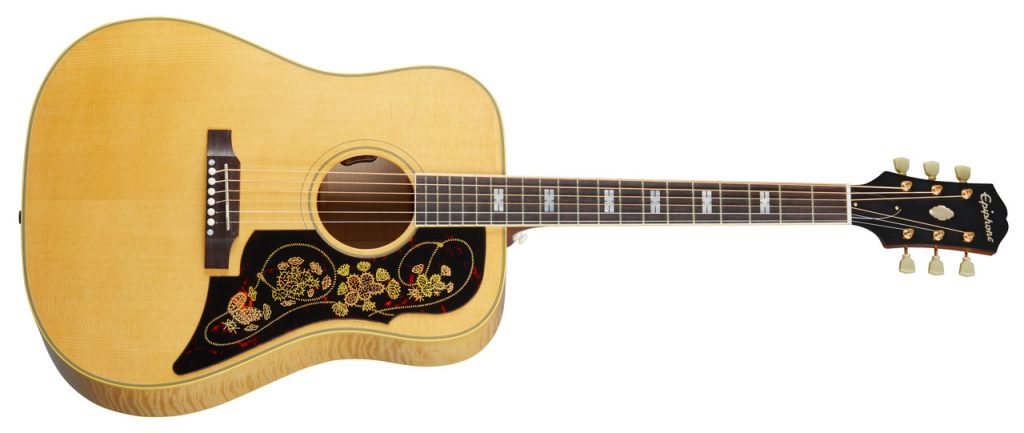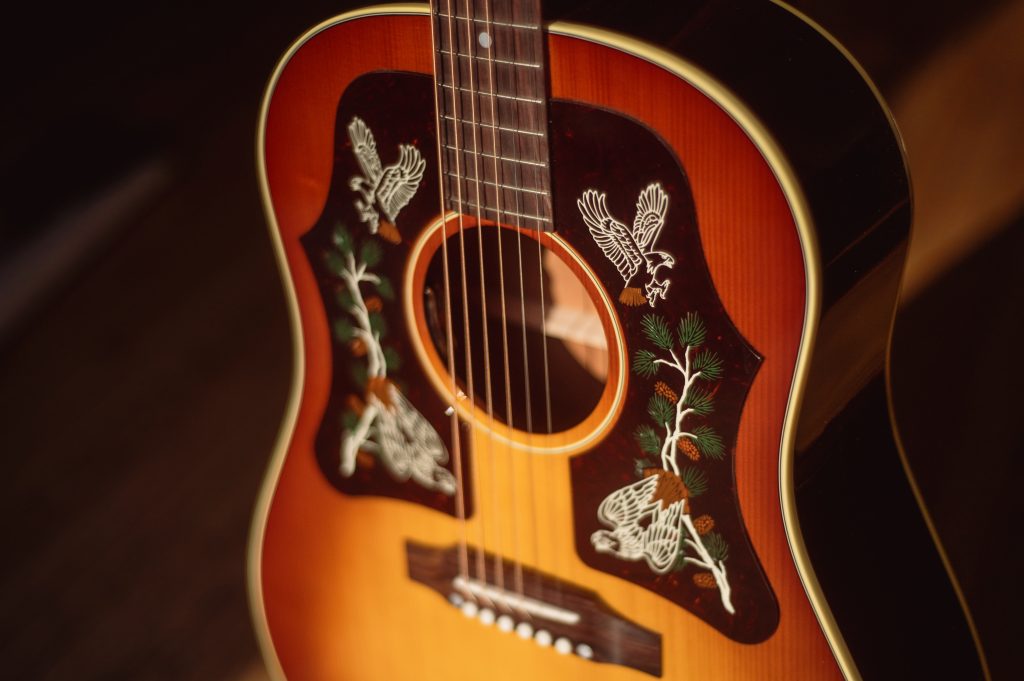The Gibson practice of adorning acoustic guitar pickguards with artwork continues a tradition of lutherie dating back to the Renaissance
Although the primary function of an acoustic guitar’s pickguard is to protect the soundboard from playing wear, its role in guitar design extends far beyond mere practicality. Pickguards—or scratchplates, to those of you reading from across the pond—offer an inviting canvas for artistic expression, reflecting the guitar maker’s craftsmanship, the player’s personality, and even historical milestones.
As part of a design ecosystem, the selection of tonewoods, finishes, binding, inlays, and bridge shapes, the pickguard is one part of a larger aesthetic statement—a fulfillment of complex processes that boggle the mind. Even things you can’t readily see with the naked eye, such as the Plek® process or how the action is set, all add up to form an attractive whole, with an allure that beckons a guitarist from a distance and during play and makes a statement to the audience.

Image: The Gibson Custom J-45 Orville Artisan 130th Anniversary Limited Edition is a tribute to 130 years of lutherie
Let’s be honest—we love acoustic guitars in part for their captivating details, pickguards included, and the deeper meaning they embody. Gibson doesn’t just offer generational musical instruments; the brand offers an enduring legacy, especially in the realm of acoustics, which are often among the company’s most meticulously handcrafted creations. Each guitar, from its beautifully decorated pickguard to its resonant body, carries forward a tradition cherished by both players and collectors alike.
Don Ruffatto, Custom Acoustic Made to Measure Project Manager, says, “We pride ourselves here in Bozeman for doing more handwork than any other major manufacturer on every guitar we build.” He’s not kidding. If you hop into the acoustic-centric episodes of the Gibson TV show, The Process, you’ll see just how much energy and planning go into the realization of a Gibson acoustic guitar. “Like and subscribe,” as the cool kids say, to learn much more.
The practice of decorating guitar pickguards with intricate artwork and symbolism is not a modern innovation; it aligns with a historical tradition dating back to the Renaissance, the era when the guitar evolved significantly into its modern form. Early stringed instruments, such as lutes and Spanish vihuelas, often featured detailed marquetry, mother-of-pearl inlays, and decorative motifs, establishing a precedent for aesthetic embellishments that more contemporary manufacturers such as Gibson continue to honor and expand upon.

Image: The Epiphone Frontier features a “rope and cactus” pickguard design that playfully channels the frontier spirit
Today, the embellished pickguard remains an iconic characteristic of many acoustic guitars, underscoring the rich history, artistic tradition, and enduring appeal of visual storytelling in instrument design. Instruments such as the Gibson Hummingbird™, first introduced in 1960, showcase intricate pickguard designs featuring elaborate floral and bird motifs, making them instantly recognizable and sought-after. Similarly, the Epiphone Frontier, first produced from 1958 until 1970, is famous for its distinctive “rope and cactus” imagery, capturing the adventurous spirit of the American West.
Beyond standard production models, Gibson has often collaborated with notable artists to create signature acoustic guitars with personalized pickguard artwork. These collaborations frequently result in unique, detailed graphics, such as custom designs commemorating a musician’s career or symbolic representations meaningful to the artist. More on that shortly. First, the basics.

Image: The Gibson Custom Brian May SJ-200 12-String was launched at the Gibson Garage London and features a a planetary-themed pickguard designed by the legendary Queen guitarist and astrophysicist
What is a pickguard?
A pickguard, known as a scratchplate in the UK (it’s like the tubes/valves thing) and sometimes abridged to merely ’guard, is a protective covering made from celluloid, plastic, wood, or similar durable material, attached in various ways to the body of guitars and other stringed instruments. On an electric guitar, it’s usually screwed down or mounted via a bracket. On an acoustic, it’s typically glued in place.
As mentioned, a pickguard’s primary role is literally to guard the top from picking damage; safeguarding the instrument’s finish and the wood beneath against scratches from fingernails or picks—see Willie Nelson’s guitar “Trigger” for an example of what can happen to the structural integrity of an instrument over decades of use if there’s no pickguard. Yikes! He doesn’t seem to mind.
Secondarily, the pickguard can serve as an artistic statement, identifying the model and manufacturer more clearly or presenting a thematic element, such as the Vic Rattlehead artwork featured on the Dave Mustaine Songwriter in reference to the longstanding Megadeth mascot. The Rattlehead theme is continued on the mother-of-pearl peghead inlay, completing the effect.

Image: The Gibson Custom Margo Price J-45 features beautiful double pickguards with a red-tailed hawk design
Early Gibson pickguard history: Functionality first
In addition to their iconic tones, legendary Gibson acoustic guitars have earned fame for their visual appeal, including their distinctive pickguard artwork. Over time, Gibson pickguard designs have evolved, mirroring aesthetic shifts and practical needs. Let’s explore that a bit.
During the early 1900s, Gibson launched its L-1 model, which by 1908 was among the first to incorporate a pickguard explicitly designed to prevent scratches from fingernails and picks. These initial designs were straightforward, featuring no ornamentation and emphasizing functionality above all other considerations. It would be a few decades before ornamental craftsmanship really emerged.
Introduced in 1937 and originally called the Super Jumbo, the Gibson SJ-200™ showcased a major evolution in pickguard aesthetics. Its large pickguard featured elaborate vine-and-flower engraving, making it one of the earliest Gibson guitars to highlight decorative elements. Besides protecting the instrument, this ornate pickguard established a tradition of artistic pickguard designs and significantly enhances the guitar’s visual appeal. As we’ll see in a moment, plants and animals have often been incorporated into Gibson pickguard designs.

Image: The Jimmy Page 1964 SJ-200 Collector’s Edition features the classic SJ-200 pickguard artwork
In 1960, Gibson unveiled the Hummingbird, immediately recognizable for its distinctive pickguard artwork. Designed by Hartford Snider, this pickguard featured an intricate depiction of a hummingbird hovering among flowers. Such a creative embellishment made the Hummingbird visually distinct from other acoustic guitars in the Gibson acoustic lineup.
Snider later created the pickguard art for the Dove™, and the eagle featured on the Epiphone Excellente. If you’re a beginner and love birds, the Starling from Epiphone features pickguard art in a similar style for an attractive price.
Throughout the history of Gibson, pickguard materials and manufacturing methods have continually evolved. Initially crafted from celluloid, a material susceptible to shrinkage, warping, and distortion, pickguards later transitioned to more stable plastics to resolve these issues—though affection remains among guitar fans for vintage materials.
Around 1968, Gibson introduced screwed-on pickguards on certain acoustic models, providing greater stability, durability, and precision in placement. Some of the models impacted by this somewhat divisive spec change were the LG, Dove, Hummingbird, and J-45.

Image: Hartford Snider created the artwork for the Gibson Hummingbird, Dove, and Epiphone Excellente
Things change, however. Today, Gibson produces acoustic guitars featuring a wide range of pickguard styles, from classic engraved artwork to sleek, contemporary designs. By blending protective function with creative artistry, the pickguard continues to play a crucial dual role for Gibson and Epiphone guitars. Let’s explore some recent entries into the Gibson acoustic pantheon that feature beautiful and unusual pickguards.
Gibson Custom Margo Price J-45
Award-winning singer-songwriter Margo Price has unveiled her new signature Gibson Custom J-45 acoustic guitar, a collaboration inspired by her cherished mid-1960s J-45, featuring striking double pickguards adorned with artwork of red-tailed hawks—a symbol Price associates with strength, perseverance, and spirituality.
Gibson Custom Everly Brothers J-180
Gibson Custom recently reintroduced the Gibson Custom Everly Brothers J-180, honoring the influential duo’s unparalleled legacy in rock ’n’ roll history. Quite simply, popular music would not sound the same without the influence of the brothers’ spellbinding harmonies and driving acoustic guitar parts.

Image: In the hands of The Everly Brothers, these guitars influenced generations of musicians
Epiphone Miranda Lambert Bluebird Studio
The Epiphone Miranda Lambert Bluebird Studio acoustic guitar, featuring a vibrant Bluebonnet gloss finish—a tribute to Texas, Lambert’s home state. Inspired by her song “Bluebird,” the guitar showcases a custom pickguard adorned with bluebird and bluebonnet artwork.
Gibson Custom Brian May SJ-200 12-String
The limited-edition Brian May SJ-200 12-String acoustic guitar was developed in collaboration with the legendary Queen guitarist and astrophysicist Sir Brian May. Gibson recently launched this stellar signature model at the Gibson Garage London, an excellent place to experience a Gibson acoustic guitar for yourself.
Gibson Custom Johnny Cash SJ-200 & Rosanne Cash J-185
Gibson Custom has introduced two limited-edition acoustic guitars honoring the musical legacy of Johnny Cash and his daughter, Rosanne Cash. What the Johnny Cash model’s pickguard lacks in adornment it makes up for in sheer size, while Rosanne Carter’s J-185 has her surname inlayed into the ‘guard.
Shop Gibson acoustic guitars, find out more about how they are made, and enjoy a peek inside the acoustic collections of famous guitarists. Also, as a helpful note, do not use furniture polish to clean your Gibson guitar, as it doesn’t end well for your pickguard’s adhesion. Instead, get proper nitrocellulose-safe cleaning supplies.

